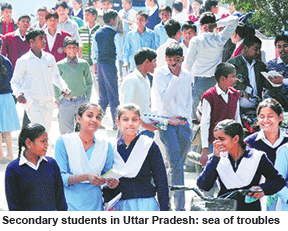Uttar Pradesh: Stressful lives
FEAR OF FAILURE, LACK OF cooperation from family, inability to control anger, sleeplessness, and poor communication skills. These are just some of the problems suffered by class X students of government schools in Uttar Pradesh — India’s most populous state (200 million) — according to a first-of-its-type study conducted by the State Council for Educational Research and Training (SCERT).
 The accumulated impact of this sea of troubles washing over the state’s 5.5 million students preparing for the school-leaving class X exam is that their IQ (intelligence quotient) and EQ (emotional quotient) are adversely affected, say the authors of the study.
The accumulated impact of this sea of troubles washing over the state’s 5.5 million students preparing for the school-leaving class X exam is that their IQ (intelligence quotient) and EQ (emotional quotient) are adversely affected, say the authors of the study.
Commissioned in March this year to government-run psychological bureaux in Lucknow, Allahabad and Gorakhpur, the study covered 1,488 students and identified 39,891 problems broadly categorised as related to school, personal and intra-personal issues, health, family and home related challenges. Further data analysis led to the startling revelation that the average 14-15 year-old in class X in UP’s 8,459 government secondary schools has to negotiate an average of 27 formidable challenges.
Comments Sarvendra Vikram Singh, director of SCERT, Uttar Pradesh: “Adolescent years are a challenge. This study helped us identify problems that impact the mental capabilities, interests, knowledge and personalities of students, which will hopefully help us deal with children better.”
Suggestions on ways and means by which adolescents can resolve some of their problems are offered in the 37-page SCERT report, which has been widely circulated in government secondaries in the state. Among the suggestions: teachers should encourage note taking in classrooms, nurture curiosity, encourage peer acceptance, refrain from corporal punishment, and identify special talents and abilities of students. For parents and guardians, it suggests delinking rewards with examination outcomes, helping with choosing friends, shunning over-protectiveness, inculcating seriousness about the school going habit without being overtly solicitous during exams, and improving inter-generational communication. Students are advised to participate in extra-curricular activities, make time for socialisation and learn to take failure in their stride.
However as numerous reports of UP’s crumbling K-12 school system have highlighted, ground conditions for implementation of the SCERT suggestions don’t exist. According to the Annual Status of Education Report 2013, published by the highly-respected Mumbai-based education NGO Pratham, only 15.6 percent of UP’s rural primaries comply with the mandated pupil-teacher ratio (1:30) and the state records the highest number of dropouts from primary education (class I-VII) countrywide. 6.4 percent of rural children don’t have access to primaries within the stipulated 2 km from their homes despite the state boasting 195,089 schools.
Moreover, the state government employs 174,320 contractual/para teachers indicating that despite the state hosting the highest number of schools (195,089), education is a low-priority vocation served by casual workers.
Dr. Dinesh Kumar Mishra of the Bureau of Psychology, Lucknow, who was involved with the SCERT report is hopeful that the conclusions of the study will prompt schools and parents to offer children greater support in their classrooms and homes. “The SCERT study represents a step forward. It is for the first time that we have measured the challenges of growing up,” he says.
Although the SCERT study has suggestions for teachers, parents and students, curiously it doesn’t offer any advice to the state government which is obliged to maintain law and order — the prerequisite of creating conducive learning environments.
Puja Awasthi (Lucknow)















Add comment